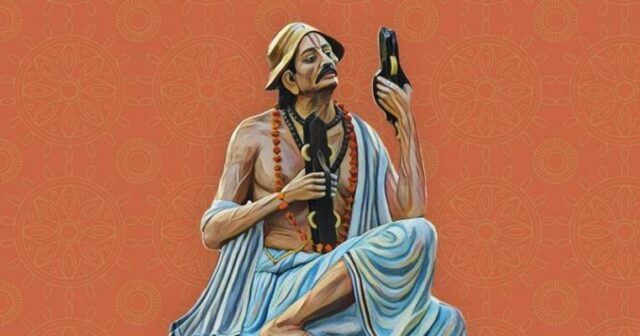
‘Vaishnav Jan To’ the favourite song of Mahatma Gandhi is among a handful of Bharatiya hymns which got the status of unofficial national anthem widely shared by hundreds of millions of people across the world and Bharat. It was composed by Narsinh Mehta, also known as Narsi Mehta or Narsi Bhagat. He was a fifteenth-century Vaishnav poet of Hindu religious tradition. He was a revered figure in Gujarat for over four centuries regarded as Gujarat’s “Adi Kavi” or pioneering poet. He did, not only invent the Gujarati poetic form but raised it to the level of the highest musical and philosophical expression. Much of what Narsinh composed as poetry, songs, ballads and verses became widely feted, celebrated and embedded into the popular consciousness of the people. His literary creations had pervaded the air of the Saurashtra region for centuries, handed down the generations as a collective treasure before reaching into years of Gandhi. He was not only a staunch devotee of Lord Krishna but also was a social reformer of great courage. Another work that gave unprecedented fame to Gandhi -calling the scheduled caste and scheduled tribe people as “Harijan” was not the brainchild of Gandhi but directly borrowed from Narsinh Mehta. (Anant Pai, 1994)
Key Points
-Mahatma Gandhi’s favourite hymn ‘Vaishnava Jana To’ was the composition of Narsinh Mehta and it was among the prayers routinely sung at the Sabarmati ashram daily.
-Gandhiji named them (SC/ST people)Harijans where ‘Hari’ means God, ‘Jan’ means people and thus ‘Harijan’ means “people of God.” Gandhiji seems to have borrowed this word from a Gujarat poet Narsinh Mehta who had used the word “Harijan” first in his devotional songs.
Harold R. Isaacs, India’s Ex-Untouchables. New York; John Day Company, 1965
– In 1933, Gandhiji renamed his weekly Young India to Harijan, because he believed that the campaign to abolish untouchability was as vital as winning political freedom. India, young (or Young) and old, present and future, had to commit itself to this sacred cause. The name quickly gained currency; among the Hindu middle classes, and the nationalist press, the Untouchables were now regularly referred to as Harijans.
-In September 1932, Gandhi had formed an ‘Anti-Untouchability League’ which was renamed as ‘Harijan Sewak Sangh’ after signing the Poona Pact with Dr B. R. Ambedkar
-The central theme of the bhajan, which is empathy, the ability to identify with the suffering of another human being. Consider a person to be pious, only if he can feel another’s pain, only if he reaches out to alleviate another’s hurt, and only if he does so without pride in his own compassion.
-The idea of who a truly righteous person is, without ensnaring its definition in religious dogma, was something that was likely to have appealed to Gandhi. “Vaishnav Jan To” is a remarkably modern, non-religious and non-dogmatic benchmark for righteous human conduct that prescribes in simple terms how to lead a dignified, compassionate life.
Biography
Narsinh Mehta, also known as Narsi Mehta or Narsi Bhagat, was born in the Vaishnava Nagar community at Talaja town of Bhavnagar district of modern days Gujarat. He lost his parents when he was 5 years old. He could not speak until the age of 8. It is said that he got his speech back by the blessings of a Vaishnav Saint. He was raised by his grandmother Jaygauri. He married Manekbai probably in the year 1429. Mehta and his wife stayed at his brother Bansidhar’s place in Junagadh. However, his cousin’s wife was an ill-tempered woman, always taunting and insulting Narsinh Mehta for his worship,he left the house and went to a nearby forest in search of some peace, where he fasted and meditated for seven days by a secluded Shiva lingam until Shiva appeared before him in person. As the popular accounts mention that Lord Krishna himself enlightened him. His nectarous experience with Lord Krishna culminated into the composition of 22,000 kirtans or compositions in the glory of God.
Enlightened and transformed Mehta returned to his village, touched his bhabhi’s feet, and thanked her for insulting him.
Mehta lived in poverty with his wife and two children, a son named Shamaldas, and a daughter Kunwarbai. He revelled in devotion to his hearts’ content along with sadhus, saints, and all those people who were Hari’s subjects – Harijans – irrespective of their caste, class or gender. The Nagars of Junagadh despised him and spared no opportunity to scorn and insult him. The compositions are collected under the category of Shringar compositions. They are full of intense lyricism, bold in their eroticism as per the Shringar Tradition of poetry.
His daughter, Kunwarbai’s marriage to Shrirang Mehta. There is a custom in Gujrat popularly known as Mamerua custom for the girl’s parents to give gifts and presents to all the in-laws during the seventh month of pregnancy. When Kunwarbai became pregnant, poor Narsinh had hardly anything except intransigent faith in his Lord. It is said that Lord Krishna helped him, he has composed poetry on same, which is famous as ‘Mameru Na Pada’.Mehta depicts how Sri Krishna, in the guise of a wealthy merchant, helped Mehta in getting his son married in his book ‘Putra Vivah Na Pada”.Mehta was challenged by Ra Mandlik (1451–1472) a Chudasama king, to prove his innocence in the charges of immoral behaviour by making the garland for Lord Himself and how God saved him is composed in ‘Har Mala’.
In the later phase of his life, He moved to Mangrol where, at the age of 79, he is believed to have died. The crematorium at Mangrol is called ‘Narsinh NuSamshan’ where perhaps one of the greatest sons of Gujarat was cremated. He will ever be remembered for his poetic works devotion to Lord Krishna and spreading affection and love for all.
Courtesy : ORGANISER
Watch Below Video also..














